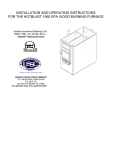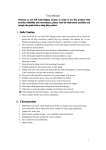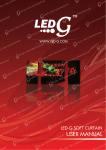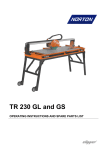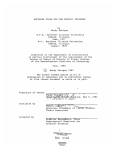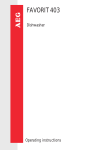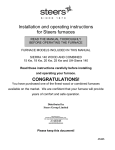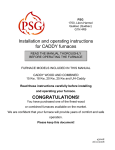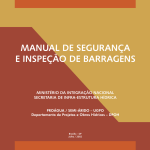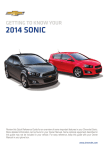Download Ilyushin IL-14-P - The X
Transcript
Ilyushin IL-14-P Passenger modification with 32 seats and ASh-82T engines Model for X-Plane 9.30 User's manual 1 Table of contents Short-story description of airplane.......................................................................................................3 Contacts and gratitudes.........................................................................................................................3 Installing the model, work with the plugin...........................................................................................4 Cockpit of airplane Il-14......................................................................................................................5 Buttons for the call of panels...........................................................................................................6 General view of flight deck.............................................................................................................7 Explains of panels and devices ............................................................................................................8 Main panel (menu)...........................................................................................................................8 Control panel (service menu)...........................................................................................................8 Payload panel...................................................................................................................................9 Fight captain's panel......................................................................................................................10 Artificial horizon AGK-47.............................................................................................................12 Aviation clock ACHS-1.................................................................................................................13 First flight officer's panel...............................................................................................................14 Central panel..................................................................................................................................15 Panel of autopilot...........................................................................................................................16 Pilot's overhead panel....................................................................................................................17 Panel of radio-compass set ARK-9................................................................................................19 Central stand of pilots (upper part)................................................................................................20 Central stand (underbody).............................................................................................................21 Panel of navigator..........................................................................................................................22 Panel of radio operator...................................................................................................................23 General information about an airplane...............................................................................................24 Geometrical information................................................................................................................24 Weight information........................................................................................................................24 Flying characteristics.....................................................................................................................25 Speed limitations............................................................................................................................26 Flying limitations...........................................................................................................................26 Minimum required length of RUNWAY........................................................................................27 Limitations of systems...................................................................................................................27 Modes of engines...........................................................................................................................27 Procedures..........................................................................................................................................28 Pre-flight preparation.....................................................................................................................28 Start and warming up of engines..................................................................................................30 Taxiing...........................................................................................................................................32 Take off and climb.........................................................................................................................32 En-route flight................................................................................................................................33 Descend..........................................................................................................................................34 Landing..........................................................................................................................................35 Turning off the airplane.................................................................................................................37 Special cases on flight........................................................................................................................39 Engine failures...............................................................................................................................39 Landing gear fail............................................................................................................................41 Fail or detachment of flaps............................................................................................................41 Check-lists..........................................................................................................................................42 Short reference of units......................................................................................................................43 2 Short-story description of airplane Short-story description of airplane Thank you for purchasing new model Il-14 for X-plane9.30 The airplane of Il-14 was projected in 1946-52 as development of airplane Il-12, called to replace a Li2 on air-routes, out-of-date by that time. Creation of new model is conditioned the necessity of increase of reliability, and by the increase of distance of flight. For subsequent 30 years the airplanes of Il-14 made the considerable epoch of distant transportation, creations of new air-routes and mastering of arctic territories of Earth. This model is called to recreate and historically reproduce this known airplane. The package of Il-14 contains the detailed three-dimensional model of airplane with the complete reproducing of all movable parts and their possible absence; close to the real physical model of airplane with the recreation of many distinctive descriptions of the real prototype. In a cockpit all devices and systems are recreated with inherent them original logic of work and refuses. Most management organs accessible from a three-dimensional virtual cockpit, and some panels are doubled as pop-up flat windows. Although in this model some retreats are possible from reality, author recommends to familiarize with real POH of airplane Il-14. Contacts and gratitudes Model author, devices and logic is Andrey Kozyaruk (Felis) e-mail: [email protected] An author of the module of user avionics is Alexander Babichev (Asso) Model's author expresses the gratitude to Mel'nikov Alexander Evgenievich — author of site of http://aviaros.narod.ru/avio.htm for given photos; To Yuriy (Omega) and Vladislaw Blindin for technical consultation. Special gratitude of Rubcov Nikolay Aphanasievich, for testing model and technical consultation. Nikolay Aphanasievich is former captain of Il-14 from the beginning of its exploitation to 1986 year, working in governmental detachment, after at the Perms airmotor factory. In post-war years provided the air special delivery of cabinet of ministry on the USSR. Deserved veteran of Aeroflot. Long years to you and salubrity! 3 Installing the model, work with the plugin Installing the model, work with the plugin At the purchase of model on the site of http://store.x-plane.su/ you got the archive of «Il-14_930_ENG.zip». To install model in a simulator, you are enough to unzip an archive in a catalog with other models, related to the general airplanes. For example: X-plane 9.30\aircraft\general Aviation. This model contains the plugin - module of custom avionics for rendering devices and treatment of their logic. The feature of this module consists in that to install it in a general catalog for the plugins in simulator NOT REQUIRED. At opening a model in a simulator — the module is loaded automatically and unloads at the open of other airplane. The module of custom avionics constantly develops and you can find its updates on the site http://code.google.com/p/sasl/ under the name XAP. For replacement of the module it is necessary to delete or carry elsewhere content of catalog of Il-14_930\plugins and replace with new files, taken from this site. Module of custom avionics, and all devices and logic are open and free. It means that you quite freely can use these components in the aims, to change and integrate in the projects on condition of maintainance of authorship. With questions for licensing it is necessary to contact to the authors (see this higher). As already talked higher, the module is started at opening a model in a simulator. However during making alteration there is not a necessity to reopen a model while coding of devices. The module reacts on the hotkey of F8, pressing of which will reinitialize the module. It should be remembered that any errors in a code can result in unforeseeable consequences, and that is why if an user will decide to change something in-process devices he does it on his fear and risk. Authors carry no responsibility for possible harm, brought in the case of bringing of the changes by user in the source code of the module, devices or logic. However an user always can appeal for a help by the addresses indicated higher. 4 Cockpit of airplane Il-14 Cockpit of airplane Il-14 The crew of airplane of Il-14 consisted of four persons: captain, co-pilot, navigator and radio operator. Each of members of crew had the workplace, which are recreated in this model. Model of Il-14, besides built-in functions, to the inherent airplanes in X-plane, contains the great number of additional, about which it will be said below. As in a simulator by only one man flies an airplane as a rule, he has to play role of each of members of crew. For the facilitation of access to the necessary organs of management pop-up panels are foreseen in this model. On them the special menus are taken away for a management these panels, by a management the external equipment of airplane, calculation of its load and centration. Most pop-up panels can be caused through the hotkeys and/or buttons in a virtual cockpit. This illustration shows the location of click-zones (areas sensible to pressure) of mouse for the call to often used panels. 1 - call of main menu 2 - call of overhead panel 3, 4 - call of central panels 5 - call of panel of navigator 6 - call of panel of radio operator 7 - call of panel of autopilot 8 - a show GPS device 9 - hiding/show of steering wheels Every panel appears in the predefined place, however there is possibility to dispose them at own discretion. It is for this purpose enough to click mouse in available from click-zones space on a panel and to «drag» a panel. There is the special area in a right lower corner, dragging for which, you can change a size and proportions of panel on the discretion. Closing of panel is produced by clicking the cross in the right overhead corner of pop-up window, by pressure of combination of the keys on which a panel reacts or by pressure on the proper button in a cockpit or on a panel with a menu. 5 Cockpit of airplane Il-14 Buttons for the call of panels Shift + F2 is a main menu of management panels and ground power Shift + F3 is a panel of calculation of fuel, commercial load and centration Shift + F4 is an overhead panel of pilots Shift + F5 is overhead part of central panel Shift + F6 is an lower of central panel Shift + F7 is a panel of radio operator Shift + F8 is a panel of navigator Shift + F9 is a panel of autopilot 6 Cockpit of airplane Il-14 General view of flight deck On the picture rotined higher the location of basic panels of pilots and their division is represented on functionality: 1 is an overhead panel of pilots. Doubled by flat panel. 2 is a panel of captain of airplane 3 is a middle panel of pilots. Aviation clock and magnetic compass 4 is a panel of co-pilot 5 is overhead part of central panel. Doubled by flat panel. 6 is an underbody of central panel. Doubled by flat panel. After the backs of pilots, the workplaces of navigator and radio operator are located. At a desire you can glance there in a simulator — they are functional. More detailed description of panels and devices see is in the next chapters of this guidance. 7 Explains of panels and devices Explains of panels and devices Main panel (menu) The main menu of airplane is executed in a semilucent kind, that an user was in a position to work with it and see the applied changes. On a main panel the call of all panels of airplane Il-14 buttons are located, including the menu of loading and service. Here is possibility to show/hide steering wheels and GPS device in a virtual cockpit. As the real airplane was not completed with similar device — in this model it is hidden by default. The button of query of ground power is located in a right lower corner. In the case of availability — a ground power is connected for a few seconds and button changes a color from red to green. Control panel (service menu) A service panel is executed semilucent. Here is possibility to open or close practically all opened parts of airplane, including hoods, skirts, hatches and doors. On this panel there are the buttons for covering of engines and Pitots, settings of brake heels under the wheels of undercarriage. In a right lower corner there is the button for rapid preparation of airplane to flight, pressure on which forces the closure of all hatches and uncover the engines and Pitots. 8 Explains of panels and devices Payload panel The panel of load of airplane logically parts on two parts: calculation of fuel and determination of load and centration. For determination of necessary fuel for flight, user must enter in cells under a left chart distance between air-ports, estimate speed of wind enroute, desired speed of flight and stocked fuels over a calculation. The input of values is produced by pressing a mouse on the left and on the right from number, by pressing on the left will decrease the number, on the right — will increase. Speed of wind (longitudinal constituent) is specified relative course of flight. Positive values are the following wind, subzero — meeting. Stocked fuel determined from the calculation of expense of engines on earth, including warming up and taxiing (160 l/h on both engines, but no more than 80 liters) and navigation supply (550 l/h on two engines, but no less than 55 liters.) For determination of load and centration the right chart of panel is used. Here user must enter the amount of passengers on rows in a salon, load of luggage racks, use of cloak-room in winter time (the number of passengers will be represented), including weight of buffet air steward and amount of members of crew. Pay regard to 9 Explains of panels and devices 6th line chart: it is used only in the case of the complete filling of salon. The result of calculation is an amount of fuel in litres, flight mass in kilograms and centration of airplane in % of MAC (mean aerodynamic chord ). Crossing of red lines on a nomogram corresponds a load and centration of airplane taking into account a fuel, dark blue — without an account (supposed load at landing after making of fuel). It should be remembered that too backward or the too forward position of centerf of gravity of airplane results in worsening of its control and flying descriptions. The optimum is consider a centration 16-19% MAC. After completion of calculations it is necessary to press on sign «Load an airplane», wich will record the results of calculations in a simulator and load the model. Note should be taken, that a load «by default» for this model is load, proper the empty equipped airplane with a crew, air steward, and by some supply of food stuffs in a buffet. In fuel tanks here is the only unproduced remain of fuel. Fight captain's panel Flight captain's panel — first that you see after the load of airplane and basic work of pilot in a simulator is conducted exactly here. Using and metages devices of this panel: 1 is pressure in a hydraulic accumulator, kg/sm2 10 Explains of panels and devices 2 is pressure in the brake system of the left and right contour, kg/sm2 3 is total pressure in the hydraulic system, kg/sm2 4 is a pointer of course. A device is related to the gyro-compass of airplane and is in a position of turn of scale for comfort of counting out of courses in relation to the turn of map. 5 is the button «lamp test». Pressing will lit all lamps in a cockpit for the exposure of out-of-commission. In this model the refuses of lamps in a cockpit are not foreseen, but this button will help to define the presence of power in a plane's network. 6 is a pointer of air speed. Testimonies in tens km/h 7 is a barometric altitude indicator. Two pointers shows an altitude in hundreds of meters (large) and in thousands (little) in relation to the set pressure in mm.Hg. Pressure is set by rotary knob at the bottom of device. A little three-cornered pointer after a scale is intended for calibration the device at the plant. 8 — combined indicator of turn and sliding. 9 — lights of signaling of flight over markers. Green — outer, yellow — middle, red is inner. After flight middle (inner, at presence of his in air-port) it is necessary to make decision about landing or go around. 10 — indicators of fire are in engines. 11 — combined artificial horizon, indicator of turn and sliding AGK-47. Description of device see below. 12 — pointer of rate (variometer) of climb, m/s 13 — indicator of position of wing flaps. Overhead position of pointer — retracted, lower — extended. Degrees of rejection. 14 — pointer of the landing system on the ILS - PSP-48. A vertical slat shows the off-course of airplane, horizontal is deviation from glide slope. Two lights under a device signal maximum rejection and direction for a return on a course. White flags indicates about absence of signals. 15 — gyro half compas. A device is related to the gyro-compass and has rotary knob for fine tune. 16 — combined pointer of giro- and radio compass #1. An external scale is intended for counting out of bearings, internal — related to the gyro-compass and serves for counting out of course corners. A yellow pointer specifies sending to the beacon station at presence of signal from it (in the case of no-signal — a pointer moves chaotically, following by noises in an atmosphere, at the turned off receiver of radio compass — stops beating in the last position). A double white pointer is 11 Explains of panels and devices revolved by knob on the left-below of a device and serves for setting of course of flight or landing. 17 — pointer of radio compass #2. A needle is specified by bearing on the wireless station. 18 — radio-altitude indicator. For power ON this device the turning button serves on the left down (the “ON” sign turned to horizontal position). A device is able to count off a height above a terrain or water under aircraft within the limits of 0 1200m or 0 — 120m. Switching of ranges is the overhead right turning button. 19, 20 — indicators of remain of fuel in the right and left group of tanks accordingly. An indication is in liters, limit of measuring of 1600l. lights under devices signal remain of fuel less than 200l in the proper group. 21 — lamp-indicator of marker receiver. Catches fire at flight above any marker. A sound signal is thus included (bell) Artificial horizon AGK-47 The combined device of AGK-47 consists of: 1 is rotary knob of zero-adjusting horizon 2 is the button of arrest 3 is an airplane-indicator spatial position of airplane. An indication is straight. The roll of aircraft is represented by the turn of airplane in relation to a zero, pitch — by vertical motion. A right roll is a right turn, left — left. Raising of nose of airplane — an indicator rises, lowering — goes down 4 is an indicator of turn of airplane 5 is an indicator of sliding of airplane 6 is a flag of the arrest system. For work with device, there must be a power in the electric system of airplane, and on the overhead panel of pilots tumbler of power of device is turned ON. Pressing the button of arrest results in setting of indicator in a zero position regardless of position of airplane. Attention: to arrest only in horizontal flight. After an arrest it is needed to push the button of arrest once again — a small flag will disappear and a device will be ready to work. An error can appear in the process of work in the testimonies of device, for the removal of which it is needed to conduct an arrest repeatedly. In loss 12 Explains of panels and devices of power a device is heaped up. Aviation clock ACHS-1 An aviation clock is intended for the reflection of current time (UTC), counting out of block and measuring of small intervals of time. 1 is the button of starting of counting out of block hours. First pressure — a timer is started, second — stops, third — throws down in a zero. 2 is the button of starting of stop-watch. Works like the button 1 3 is the large scale-reading time. Pointers: hours, minutes, seconds 4 is a little scale for counting out of block hours. Pointers: hours, minutes. A small flag in a center symbolizes work. Red — a timer is started, red/white — a timer is halted, white — a timer is downfaulted in a zero. 5 is a little scale of stop-watch. Pointers: minutes, seconds In a sunset-to-sunrise a clock illuminate from beneath a green color — scales and pointers have phosphoric coverage. 13 Explains of panels and devices First flight officer's panel Most devices on the panel of co-pilot like the devices of captain. 1, 2 are pointers of radio compass 1 and 2 according 3 is pressure of oil on an exit from engines, kg/sm2 4 is a temperature of oil on included in engines 5 is a temperature of oil on an output 6 is Lamp-Warner of flight of marker 7 is the button for the check of lamps work 8 is an indicator of landing of PSP-48. 9 is gyro half compass 10 is combined artificial horizon AGK-47 11 is a variometer 12 is a air speed indicator 13 is a barometric altitude indicator 14 are indicators of position of landing gears. Pointers above — an gears is retracted, down — an gears is extended. Under devices there are signaling lamps. 14 Explains of panels and devices Red — a landing gears is retracted, yellow – the gears in intermediate position, green — gears are extended. 15 are indicators of flight over outer, middle and inner markers 16 is an indicator of temperature of outward air in a range from — 50 to +150 degrees of Celsius. 17 are indicators of position of skirts of hoods of engines. Pointers upwards — skirts are fully closed, downward — fully opened. Central panel 1 is a magnetic compass 2 are indicators of pressure in the pumps of serve of alcohol of the system of heating 3 is an aviation clock ACHS-1 4 is a control an autopilot panel. More detailed work with an autopilot is described below. 5 is a two-pointer tachometer of engine. 6 is an indicator of manifold pressure of engines. 7 is a temperature of cylinders of the first star of engines 8 is a temperature of cylinders of the second star of engines 9 is pressure of fuel on included in engines 10 is pressure of oil on included in engines 15 Explains of panels and devices Panel of autopilot The airplane Il-14P is equipped an autopilot AP-45, to working on three channels. An autopilot is able to retain a permanent course, roll and pitch of airplane long time without intervention from a pilot. The panel of autopilot parts on two parts: management to on-course and according to the spatial regulations of airplane. 1 is knob of correction of gyro-compass of autopilot. 2 is knob of choice course of flight. L is a turn to the left, R is a turn to the right. 3 is knob of setting the pitch of flight. D is descend, C — climb 4 is knob of setting the roll of flight 5 is a scale of choice of course. you will pay attention, that a course is specified by a mark 0, as this device is based on relative deviations from initial position. 6 is a scale of gyro half compass. 7 is a marker of settings of roll 8 is an indicator of current roll of airplane 9 is a marker of setting of pitch. A dark blue area is pitch up, black is down. A scale is marked through 10 degrees. 10 is an indicator of current position of airplane. Work of him is analogical work with artificial horizon. For work with an autopilot: 1. Before its switching ON you need to combine the markers of course (to set a scale in a zero), roll and pitch according to the current condition of airplane. 16 Explains of panels and devices 2. Turn right both faucets on the lower panel of central stand of pilots. 3. On wing to manipulate pens «turn» for the correction of course, «pitch» for a set, climb and descend and «roll» for manoeuvres. For implementation of maneuver through the autopilot of AP45 it is needed to choose the desired roll and since an airplane will bend over — to revolve the handle of choice of course to setting of marker 0 on a necessary course. At to approaching to the necessary course — fluently to clean a roll. It is necessary to take into account that the autopilot of AP45 is retained by a course through the rudder, and that is why appearance of sliding of airplane is some time possible. Pilot's overhead panel On an overhead panel followings switches and devices is located: 1, 2 are sets of radio compass 1 and 2 accordingly. More detailed than see below. 3 — set of frequency of landing of Nav1 4 is switches of extend/retract of landing lights 5 are switches of landing lights 6 is a switch of taxi light 7 are switches of heating of Pitots 8 are switches of artificial horizons 9 a switch of gyro half compass 17 Explains of panels and devices 10 is a switch of heating propellers 11 are lamps of control of heating of propellers and wings. 12 — a switch of TP-156 is a basic switch of device panel. 13 is a switch of heating of wings 14 are switches of start of engines. Overhead position starts left, lower — right. Midposition — neutral. 15 is a switch of starters. It is necessary to turn ON for the start of engines. 16 are switches magneto of engines. Lower position is a magneto turned off, aside is a magneto turned ON. Intermediate positions connects only one from two magneto. Areas for mouse-click is out of the limits of white circle on his perimeter. 17 is tumbler of switching of power, closed by a red lid. For opening of lid it is needed to click a mouse on the right from it. Overhead position is connect the accumulator, middle — it is turned off, lower connects a ground power supply to the plane's network. As a capacity of storage battery is small, during the protracted work in a cockpit on earth it is recommended to connect a ground power (main panel). The start of engines is recommended from a ground power, batteries are used only in extreme cases. 18 is a switch of light board to «fasten straps» in a salon 19 is a switch of heating windows 20, 21, 22 are switches of external navigation lights. Red beacon on a tail, red and green lights and strobes on wings. 23 are switchers of primers of fuel in an engine. It is recommended to turn on before a start. 18 Explains of panels and devices Panel of radio-compass set ARK-9 On the face of it very difficult device, but on work with it is very simple. 1 is a switch of device. For turning ON it is enough to set in position «комп» or «рам». 2 — a switch of sources. In this realization of device — commutes sets of frequencies below. Left or right. 3 is an indicator of chosen set. 4 is a large disk of set of frequency. Collects hundreds of kilohertz in a range from 100 to 1200. Click-areas are above and down from the center of disk. 5 is a little disk of set of ten of kilohertz in a range 00-90. click-areas are on the right and on the left of center of disk. 6 is rotary of the fine tuning. In this realization of device collects units of kilohertz of frequencies 0-9. For set and reading of the setted frequency numbers - at first read in the window of disks and to them the values of fine tune are added. On a picture frequencies are set 1190 and 689 kHz. 7 is indicator of tune level on the station. 19 Explains of panels and devices Central stand of pilots (upper part) A central stand contains the levers of management the fuel system and engines. 1, 2 are fire valves. Recovers a fuel directly at engines. Overhead position corresponds the opened valves, lower — it is closed. 3 are the buttons of fire-extinguishers in the left and right engine accordingly 4 are the buttons of feathering propellers. In the case of one of engines fail, for diminishing of air resistance, propeller of this engine must be feathered by pressing of the button. For the conclusion of propeller in an operating condition — it is necessary to wring out the button. 5 are Lamps-Warners of work of fire-extinguishers. 6 is tumbler of turning ON pumps for pumping over of fuel in direction, to the proper position of switch. 7 are switches of fuel pumps. Create pressure of fuel. 8 are lamps-indicators of work of fuel pumps. 9 is an indicator of position of trimmers of helm of height. For a management a trimmers it is necessary to press higher or below than this indicator. 10 are levers of management fuel mixture. For diminishing of consumption of fuel and increase of their efficiency engines, it is necessary to pick up mixture thus, that position of levers was minimum possible, but engines worked to capacity here. Impoverishment of mixture will result in muffled of engines. 20 Explains of panels and devices 11 are levers of management the supercharge of engines. Right after the start of engine a supercharge is recommended a bit to increase. It is related to that at a minimum supercharge engines produce an underpower which not enough for maintenance of small turns and can result in muffled. 12 are levers for a set propeller's speed of rotation. Overhead position corresponds maximal turns, lower — minimum. For taxiing levers need to be set in a midposition; for flight — in extreme overhead. It is necessary here to remember that the too large turns of props can result in death of engine and its failure. Detailer information about limiting to see in next chapters. Central stand (underbody) 1 — switches of dust filters 2 are switchers of opening and closing of skirts of hoods of engines. For the complete opening it is needed to press several times downward, closing — upwards. 3 — opening/closing of oil radiators 4 is a lever of setting of stand brake. 5 is a regulator of illumination in cockpit 1 —6 it is a lever of extend and retract of landing gear. Two positions: retracted and extended. 7 is a lever of rejection wing flap. Three positions: cleaned, take-off position, landing position. 8 are handles of turning ON an autopilot 9, 10 are click-areas for an overhead lever 11, 12 are click-areas for lower. For turning ON of autopilot both levers are needed to turn to the right. The overhead here must look downward, lower — to the right. 21 Explains of panels and devices Panel of navigator The panel of navigator is given by possibility more exactly to control the position enroute through more exact devices for a navigation. Devices 1 — 7 already examined in preceding chapters. It is an aviation clock, pointer of device speed, barometric height-indicator, radioheight-indicator, indicator of temperature of outward air, pointer of course and variometer. 8 is a two-pointer pointer of navigator. Pointers are numbered and specify sending to the radio beacon. An external scale is immobile and serves for counting out of bearings. An internal scale is connected with a gyro-compass the testimonies of which can be tuned by rotary «course» down on the right. 9 is a large gyro-compass with the cost of division a 1 degree. 10 is a plane-table of user maps. Unique device, allowing to open up to five maps, geared-up an user. For creation of map, it is needed in any graphics editor to prepare files in the format PNG, to name them map_1.png, map_2.png.... map_5.png and to save them in a catalog with airplane. A plane-table is able to open the images of practically any size, however desirable it is to adhere to the followings rules: 22 Explains of panels and devices 1. sizes of sides of image must be power of 2. that 128, 256, 512, 1024, 2048, 4096. 2. the largeness of picture will result in the superfluous loading on a video card, that is why it is desirable to create maps not bigger than 2048*2048. There is possibility to commute maps, scale them and move into a plane-table by the method of Drag&drop on a plane-table. Panel of radio operator The panel of radio operator is intended for the conduct of radio contact with controllers and management the electrical equipment of airplane. 1, 2 — sets of frequency of Com1 and Com2 3 is a panel of transponder. 4 is lamps of generators. Attention, if lamps lites, means a generator does not work. It means that either a generator is turned off either his engine does not work or a generator broke ranks. 5 are switches of generators 6 are indicators of current of generators. 7 are switches of inverters. For energising in a side network with different tension (36V, 115V) — it is necessary inverters to turn ON. 8 is an indicator of charge of battery. Nominal tension of battery — 24 volt. However as far as its digit, tension falls gradually. At a pickoff to 19V, greater part of devices of airplane becomes disconnected. A battery revives only from generators and has a small capacity. On earth it is recommended to use a surface power supply. 23 General information about an airplane General information about an airplane Geometrical information Height of airplane (overhead point of keel), m - 7,8 Length of fuselage, m - 21,31 Scope of wings, m - 31,7 An area covered, m2 - 100 Mean aerodynamic chord (MAC), m - 3,412 Corner of rejection of ailerons upwards - 25°± 1,5 ° Corner of rejection of ailerons downward - 15°±1° Maximal corner of rejection of wing flaps - 45°±2° Take-off corner of rejection of wing flaps - 20°±1° Scope of horizontal plumage, m - 9,25 Maximal corners of rejection of elevator: up - 30°± 1° down - 17°—1° Maximal corners of rejection of trimmers of elevator up - down 10°±2° - 17°±2° Height of vertical plumage from the axis of airplane, m - 4,512 Corners of rejection of helm of turn to the right and to the left of center - 25°-1° Weight information Mass of empty airplane, kg - 12 500 Maximal flight weight, kg - 17 500 Maximal commercial load, kg - 3000 Centration of empty airplane, %MAC - 13,2 Maximally possible forward centration, % MAC - 13 Maximally possible back centration, % MAC - 21 Centration of knocking over on a tail, % MAC - >35 24 General information about an airplane Range of optimum for flight centrations, % MAC - 16 - 19 Maximal load of fuel, liters - 3520 Flying characteristics Speed of tearing away of airplane (indicated) with the retracted wing flaps, km/h - 150—155 Speed of tearing away of airplane (indicated) with wing flaps, extended on a flight corner 17—20°, km/h - 145—150 Landing plane's speed (indicated) with wing flaps, extended on 45°, km/h - 135 —140 Landing plane's speed (indicated) with the retracted wing flaps, km/h - 150 Most most efficient (on a time-to-clime) plane's airspeed in the climb of height on the nominal mode of operations of engines, km/h - 220 Rate of climb of set of height on the nominal mode of operations of engines on the most efficient speed of climb, m/s - 5,0 — 5,5 Most efficient (on a time-to-climb) plane's airspeed in the climb of height on one engine (screw of unworking engine is feathered) on the nominal mode, km/h. 195 Rate of climb of set of height in single-engine flight on the nominal mode of operations of engine (screw of unworking engine is feathered) on the most efficient single-engine climb rate, at earth, m/s - 0, 5—0, 6 Rate of climb of set of height at single-engine flight on the take-off mode of operations of engine at speed on a device 190 km/chas (screw of unworking engine of zaflyugirovan), m/s. - 1,5 —1,7 Practical ceiling of airplane, m - 6500 The practical ceiling of airplane in single-engine flight, m - 2200 25 General information about an airplane Speed limitations High speed of level-flight of airplane at earth on the nominal mode of operations of engines, km/h - 385 High speed of airplane on one engine-on (screw of unworking engine is feathered) at earth, km/h - 290 Minimum speed on planning with the fully cleaned gas and cleaned gears and wing flaps, km/h - 125—135 Minimum speed on planning with the fully cleaned gas, and wing flaps declined in landing position, km/h - 120—125 extended gears Minimum speed is in the climb, at the nominal mode of operations of engines, km/h - 110—130 Flying limitations Maximally possible airspeed, km/h: on descend - 450 while extend landing gears and/or flaps - 290 Maximally possible wind speed for flight and landing of airplane, m/s Maximally possible 28 for flight side wind, m/s: on bearing 90° to RWY - 15 on bearing 45° to RWY - 18 Maximally possible for landing of airplane side wind, m/s: on bearing 90° to RWY - 12 on bearing 45° to RWY - 15 Maximally possible for landing of airplane in heavy weather side wind, m/s: on bearing 90° to RWY - 8 on bearing 45° to RWY - 10 Maximal operating overload, G - 3,14 — 3,4 26 General information about an airplane Minimum required length of RUNWAY RUNWAY with artificial coverage а) At take-off with the use of nominal power of engines (n= 2400 ob/min, Pk=1020 of mm.Hg) - 1100 б) At take-off with the use of (n= 2400 ob/min, Pk=1020 of mm.Hg) - 1000 take-off power of engines Gravel or grass RUNWAY а) At take-off on nominal power of engines - 1200 б) At take-off with maximal power of engines - 1100 Note. Indicated RUNWAY, in addition, must have end safety strips no less than a 250m from every side of RUNWAY. Minimum lengths RUNWAY certain from the terms of providing of the aborted takeoff at the refuse of one of engines on running approach to the moment of tearing away of airplane. Limitations of systems Maximal burn-time landings headlights on earth, min - 5 Maximal burn-time landings headlights on flight, min - 10 — 20 Maximal burn-time taxi headlights — not restrictedly. Maximum turns of engines - 2700 RPM, no more than 30 sec. Maximum temperature of cylinders of engines - 250оС, no more than 15 min. Maximum temperature of incoming oil - 90оС, no more than 10 min. Maximum temperature of going out oil - 125оС, no more than 10 min. A minimum remain of fuel is in every group - 40l Modes of engines Flight — 2600 RPM, manifold pressure 1250, power 1800 HP. Nominal — 2400 RPM, manifold pressure 1050, power 1300 HP 0.9 nominal — 2300 RPM, manifold pressure 940, power 1150 HP During the flight engines turns ned to be set within the limits of 2000-2500 RPM. A manifold pressure here sneaks up so that speed of flight was constant. 27 Procedures Procedures Pre-flight preparation As well as the real flight, virtual must be begun with preparation to it. It is foremost necessary to expect a route, specify a weather in air-ports of flight, arriving and enroute, to define frequencies of radio-beacons and channels of air traffic control. And certainly to define a commercial load and expect the necessary amount of fuel. Preparation of maps Preparation for a navigator in this model is taken to the study of route, to excerption of frequencies of the NDB-s enroute and next to it. A navigator can prepare maps for the panel of navigator. Any graphics editor, able to save images in the format of PNG, will be required for this purpose. Collect to five maps, cut them (you will delete superfluous on edges) and result in the size of sides multiple 2 (128, 256, 512, 1024, 2048, 4096). You remember that the largeness of image can create the considerable loading on a video-card. Some videos-maps can have problems with processing of images the sizes of which are not multiple 2. It is necessary to save the got images in a catalogue with airplane, naming them map_1.png, map_2.png... et cetera. In case if a simulator will not find these files — nothing frightful will happen. And on the panel of navigator simply nothing will appear in a plane-table. Determination of optimum height of flight An optimum altitude is determined coming from the least expense of fuel in a climb and descend and determined on distance of flight with clarification on a flightlevel. Real POH recommends the followings altitudes: Distance, km 300 600 900 Altitude, m 1000 2000 3000 It should be remembered that this type of airplane was not completed an oxygen equipment and system of supercharge of salon, and that is why flights 4000m is forbidden higher. Load of airplane For the load of airplane it is necessary to open the panel of load (keys of Shift+f3 or to choose the proper button in a main menu). For the input of values it is enough to call on sides from a number. Clicks on the right increases a value, clicks on the left — diminishes. As far as filling of information, you will notice as numbers and position change on graphic arts. These charts are taken from the real POH of airplane Il-14. At a 28 Procedures desire you can produce the calculations separately. For the calculation of fuel from you it will be required to enter distance between air-ports in kilometers. This distance is calculated at navigator preparation. Further we enter exemplary speed of wind enroute: positive values correspond the following wind, subzero — to meeting. Whereupon we enter speed of flight. As a rule flights are conducted on speed from 300 to 340 km/h, but the expense of fuel is considerably increased here. Flights on speed less than 300km/ch is more economical. And last: we enter additions of fuel as a navigation supply. For the calculation of commercial load a chart is used on the right on a panel. This chart fully simulates calculations on the center-determination chart of Il-14. Here you will require to enter the amount of passengers on rows, mass of load in luggage racks, mass of buffet (including mass of stewardess) and amount of members of crew. You will pay regard to sixth row which is used only for the complete filling of salon. As far as lowering on a center-determination chart, you add new displacement of centre of gravity to the last value. Just like this and work with the real balance charts The amount of fuel on a center-determination chart is taken into account automatically, when you produce its calculation. At the bottom of chart the socalled basket of safety and crossing of lines of the got centration and mass of airplane is rotined must get in this basket. Red lines are here rotin a centration taking into account a high-usage fuel, and dark blue — without. It will correspond exemplary position of center of gravity at landing, when greater part of fuel will be used up. After completion of calculations press to «load an airplane» and see how an airplane become lower on shock absorbers - it's became heavier. Pre-flight verification An innovation in this model is a necessity of pre-flight verification. In the real world it is obligatory procedure and now it is in X-plane. 29 Procedures Open the panel of service menu (opened from main menu) and commuted to outer view. We see here, that an airplane is fully sealed up and stands on stand heels (in case if an airplane was opened turned off. Otherwise plugin will configure an airplane for flight). Foremost we check whether all hatches (3, 4) and lids are closed (2). In this model possibility of «forgetfulness» of surface technicians is realized and some of hatches can be opened for you on eyes. It will be worse, if it will happen on flight — a hatch will tear off simply. Also we check up pushing a door to (1). Further we check whether technological dispersers (lids on engines (2) and covers on tubes Pito (3)) are taken off and heels are cleaned from under a landing gear (1). Last it is possible not to take away taxiing to beginning, heels can be useful at the assay of engines, but before taxiing do not forget about them. Start and warming up of engines After implementation of pre-flight verification and preparation it is possible to begin the start of engines. Grant this interesting for every simmer and as far as development of simulation this procedure becomes all more difficult. So, it is necessary for the start of engines: On the overhead panel of pilots to switch ON a power - tumbler under a red disperser (click for open on the right of it). Upper position corresponds connecting of battery, lower — surface power. For the receipt of surface power, it is necessary to inquire it from main menu. But not forget to disconnect it after a start and commuted on batteries. After turning ON the ground power, switch ON TP-156 on an overhead panel and inverters on the panel of radio operator. Right after it part of devices will be connected (gyro-compasses will turn). On a central panel, in its overhead part, open fire valves (overhead position) and fuel pumps. 30 Procedures We check whether a stand brake (lever downward) is set and again passed to the overhead panel. Here we translate the keys magneto in position of «1+2» and turning ON red tumbler of starters. . Whereupon we proceed directly to the start. We set both switchers «engine starters» in position «LEFT» and watch after the turns of engines. At their increase more than 200-300 RPM, turn ON primers and give mixture on the left engine. An engine must be dispersed to 800-1000 turns. We disconnect a start lowering of switchers «engine starters» in neutral position. Right after a start it is necessary to give a bit throttle, that an engine developed necessary power for maintenance of turns, but here not untwisted more than 1200 RPM. Like the left we start a right engine. We set both switchers «engine starters» in position «RIGHT» and repeat procedure. After a start it is necessary to open slightly the skirts of hoods (underbody of middle panel) and warm up engines to the followings indexes: temperature of cylinder heads no less than 90 degrees (no more than 225) temperature of incoming oil no less than 60 degrees (no more than 90) temperature of going out oil no less than 90 degrees (no more than 125) On achievement of the temperatures resulted higher it is necessary to open the skirts of hoods on a maximum and hold opened during all taxiing, flight and climb. While engines are warmed up, will engage in preparation of gauges. Foremost on the panel of radio operator it is necessary to turn ON generators and commute the feed of side-network on a battery for its charge on overhead panel. On an overhead panel turn ON switchers of tubes Pito, artificial horizons and GPK. Turn ON heating of propellers and wings if necessary. On the right part of panel turn ON external lamps and signal in a salon. If necessary ON the heating of windows here. Since on an overhead panel all is ON, passed to the main panel of pilots. It is here necessary to include the arrest of artificial horizons, pushing their right button and to wait till their setting in a zero. Wait a few seconds to the final stop of indicator and will disconnect an arrest. artificial horizon must remain in a zero position. On altimeter set pressure given by controller or pressure of the air field, combining both pointers with a zero. It is necessary to include a radioheightindicator, by pressure on the button on the left down from a device. We set frequencies of radio compasses and landing system. 31 Procedures Taxiing Before the beginning of taxiing it is necessary to pick up fuel mixture. Move the levers of «M» on a central panel toward impoverishment until an engine will not begin to diminish turns. It is at this juncture necessary a bit to heave up mixture. It is possible to test engines, giving them complete gas and to check whether the turns of value of 2700 RPM arrive at, however it should be remembered that even on a stand brake and small propeller's pitch an airplane can not hold out in place. That is why long retaining maximal turns is impossible in order to avoid move an airplane. It is better to conduct the assay of engines at the set blocks, however before the beginning of motion it is necessary to check whether they are cleaned. If necessary turn ON taxi headlights. For taxiing set levers of engines turns in a middle position. Thus engines will get the additional loading and possibly it will be required to add gas. An airplane must move from a place at achievement the engines of 1000 RPM and it is normal to taxi at 800-900 RPM. At taxiing on the ground or grass grounds large power of engines can be required, but no more than 1500 ob/min. Recommended speed of taxiing about 5 km/h, but no more than 15 km/h. For turns in the real airplane the separate braking of the left and right wheels of gear was used and by the serve of greater power on an opposite engine. Thus forbidden one complete braking of wheels in order to avoid breakage of bar. In a simulator you can use the axis of YAW for the turn of nose wheel and implementation of turns. Before a taxi-out on an executive start not forget to turn ON transponder on the panel of radio operator, preliminary setting in it a code, given by controller. Once again we check up work of all devices and systems. We check up the rightness of rejection of helms and ailerons, set trimmer on flight position (+2 - +5 depending on a load). If necessary we extend wing flaps on flight position. Take off and climb After lining up, checking up readiness of airplane to flight and getting permission of controller extend and turn ON landings headlights, collate the testimonies of giro-half-compasses with the course of runway and if necessary correct them. It is necessary to set a zero on the overhead scale of gyro-compass of autopilot and combine the markers of roll and pitch. For the further climb it is possible preliminary to set pitch +8 degrees on autopilot. We stop up brakes by pedals and fluently lift a supercharge the levers «T» to the take-off or nominal mode, and set the turns of engine by the levers «P» in obedience to the chosen mode. We release brakes and begin running approach. 32 Procedures On speed 100 km/h fluently lift a front gear and increase pitch to 10 degrees. We continue running approach to the complete tearing away of airplane from earth. It will happen approximately on speed 145-155 km/h, depending on position wing flap and loads of airplane. In a few seconds an airplane will pass to the intensive climb of altitude. On altitude of 10-20 meters take away a landing gears and control their cleaning up on indicators on the panel of co-pilot. We disconnect landing headlights. It is necessary to clean wing flaps, parrying here diminishing of carrying capacity the small taking of steering wheel on itself. Retain the rate of climb 2-3 m/s to gathering speed 220 km/h. It is here possible to set power of engines to nominal and pass to the standard climb with the rate of climb 5-5.5 m/s. During the climb it is necessary constantly to watch after the temperature of engines and oil, and after their mode. What higher flight, the anymore it will be required to give gas, constantly retaining turns engines about 2400 RPM. For simplification of aviating in a climb and further to on a route — can use an autopilot — it is for what needed to combine on his panel markers with current position of airplane and turn both levers on a central panel. An autopilot must be connected and disconnected on alt not below 600 meters above terrain. As far as speed up, an airplane has a tendency to pitch up, that is why it is necessary gradually to drop trimmer of elevator. At using an autopilot — to diminish pitch. En-route flight At flight to en-route from you all your skills will be required in using a radio compass, compass and clock. If before flight you prepared a route carefully, flight must create no problems. A few prompts: At flight to NDB — attentively watch after position of pointer of radio compass is must constantly remain in the direction of course, indicated in your route (pointer of navigator or UGR-1). On the pointer of URG-1 you can set a white double pointer on a necessary you course and watch after position of yellow pointer in relation to white. If the yellow deviates to the left, it is necessary to give an amendment to the left, if in a right is an amendment to the right. At flight FROM the NDB station operate vice versa — watch after the opposite tag of pointer and at his rejection to the left — do an amendment to the right. On the panel of navigator, at correct preparation of maps you can watch the position, according to the mutual regulations of pointers of radio compass and position of beacons on a map. Not forget to conduct the visual looking after earth, comparing a landscape to the map and controlling the position. 33 Procedures On the flight level choose the mode of engines thus, that to support permanent speed of flight, and turns within the limits of 2000-2500 RPM. The skirts of hoods probably will require half-close, in order to avoid supercooling of engines. You can touch up mixture, but doing it is necessary carefully in order to avoid muffled of engines. (flying tests rotined that at maximal mixture expense of fuel in 1,5-2 times higher calculation and the levers of supercharge can be set a bit higher than middle) At using an autopilot small amendments in a course can be produced through a rotary «turn». For turns it is necessary to use jointly handles «turn» and «roll». For withholding of permanent altitude it is necessary to manipulate a rotary «altitude», remembering that rotation aside «D» corresponds descend, «c» - to getting climb. Descend Beginning of descend and mode of operations of engines at a motor descend is determined a preliminary calculation (by the plan of flight). If for some reason a descend begins not in a calculation point, but in the area of expectation, it is necessary to pick up the mode of operations of engines such, at which speed of level-flight is remain 250 km/h of airspeed. At flights with passengers it is necessary to hold the rate of climb of decline of 1,5—2,5-m/sek, but more than 3 not m/ss, but speed on a device during a motor decline not higher 350—360 km/h in quiet air and not higher 300 km/h in the conditions of moderate bumpiness. Turbo speed of airplane is if necessary assumed on a descend, but no more than 450 km/h of airspeed. In transition on a descend with the increase of speed of flight it is necessary some more to cover the skirts of hoods. Supercooling of engines can happen on a descend, if fully to clean gas (Rk —350—400 mm.Hg.), but it is not recommended, because speed-up of engines can become worse from supercooling of cylinders and pelting of candles by oil. At a descebd in the condition of low temperatures of outward air it is necessary to spare attention the temperature condition of engines, shutting out cooling of heads of cylinders below +120°C, and incoming oil below +50°C. If the temperature of heads of cylinders and oil at this mode of descend has aspiring to the further lowering, recommended for heating of engines periodically to do horizontal flights (translating an airplane in the mode of level-flight). At the high temperatures of outward air on the air field of landing, with the purpose of diminishing of temperature condition of engines during taxiing, it is recommended on a descend to chill engines to the temperature of heads of cylinders, equal 150—160°, and to lower the temperature of oil to plus of 50— 60°C. At a descend with the connected autopilot it is necessary to turn off it on a altitude not below 600 meters above terrain. In a table the exemplary calculation of descend is below rotined at a speed of 34 Procedures order 1,5 m/s in the motor mode. Airspeed km/h For every 1000 meters of descend Time to descend, min Distance, km Fuel consumption, liters 300 11 60 65 325 11 65 75 350 11 70 90 Landing Descend of airplane from the altitude of flight level, strike-through of cloudiness and landing approach a crew executes only after the receipt of permission to landing from the leader of flights or controller. At the same time ATC reports to flight crew: а) barometric pressure on the air field; b) height of lower edge of cloudiness in meters; c) horizontal visibility in meters; d) special meteo-effects on the air field (rain, snow-storm, ice-storm). Getting foregoing information hard-over, a crew must: — to confirm the got pressure and number of runway and begin implementation of maneuver of approach to landing; — on transition level to set the scales of barometric altitude-indicators on pressure of the air field and report about it to the controller; While approach to landing a vertical descend on a final leg is maintained calculation depending on speed of wind and chart of approach by the system. In difficult weather (out of visibility of earth) a landing gear is recommended, to extend after a fourth turn, after reaching on a final approach. After the extend of landing gear decrease speed of flight from 250 to 220 km/h and to commute a radioheight-indicator on the range of small heights. Speed 220 km/h without extending of gears, saved to the approach on visual flight. Wing flaps, as a rule, to extend after passing to visual flight. At landing in difficult weather on the air field limited, icing up or wet for providing of exact calculation of landing extend wing flaps in the beginning on 20° right after the issue of gears, to produce a descend on speed 220 km/h. Further extend of wing flaps to carry out after an output on visual flight. If to establishment of reliable visual contact with the fires of the runway lights or other ground objects to on-course landing signaling of radioheight-indicator worked, it 35 Procedures is necessary immediately to begin a manoeuvre on a care on the second round. At the visual approach for landing on the small circle landing gears to produce before the third turn. After the issue of landing gear speed of flight must be decreased to 225—230 km/h. On this speed to produce the third and fourth turns. After a fourth turn speed to decrease to 200 km/chas and retain it to the moment of rejection of wing flaps. On height of a 100 m to decline wing flaps on a landing corner. After the extening of wing flaps decrease speed to 180—185 km/h. As a rule, it is necessary to extend wing flaps fully. Warning. If at landing approach in the process of extend of wing flaps the spontaneous roll of airplane is created, follows at once, not losing time on finding out of reasons of roll, translate the handle of management wing flaps upwards in primary initial position heaved “flaps retracted” and to produce landing of airplane with the cleaned wing flaps. If landing takes place at wind above 10m/s, extending wing flaps before landing more than on 20° not recommended, and if speed of wind is exceeded by 20 m/s, landing is produced only with the retracted wing flaps. At approaching on landing with side wind a fight against tearing down is conducted only the selection of the proper corner of forestaling, which cleans up on flare before landing. At stopping on landing in the conditions of the intensive icing speed on a decline after the rejection of wing flaps on a landing corner must be 185— 195 km/chas depending on the degree of icing of airplane. At approaching on landing in the conditions of the limited visibility (fog, haze, sinking) turning on the landing lights by the commander of ship desire. Produce turning ON landings lights after establishment of contact with earth. In case if at turning ON of landing lights a mixing lightsheild is created, headlights must be turned off. The instrumental landing is produced through radio compasses, adjusted on the outer and inner wireless station, and systems of SP-50 (course-glideslope system or ILS), in the case of its presence on the air field of landing. On the receiver of ARK1 it is recommended to set frequency of inner beacon and turn a double pointer on UGR1 on the course of landing. On deviations of yellow pointer from double it is possible to trace deviation from a landing course. On the receiver of ARK2 it is necessary to set frequency of the outer beacon station. On a descend on glideslope retain speed 180-190 km/h. The rate of descend must make approximately 2-3 m/s here. Height of flight on glideslope it is necessary to control during flight of the marker stations: outer marker — 200-250m, inner — 50-60m. Some airports has three markers. In that case outer marker – 600-650m, middle – 200-250m, inner – 5060m. 36 Procedures At the use of the landing system SP-50 it is necessary constantly to watch after positions of pointers on the device PSP-48 — indicator of relative position of airplane from a course and glideslope. It is necessary to aspire to that the vertical and horizontal slats of PSP-48 held out in a center. In the case of their deviation from a center — it is necessary to insert amendment in a course or rate of climb of flight toward the rejection of pointer. For withholding of airplane to it is on-course necessary to work as rolls, for withholding on a height — by gas of engines and small motions of steering wheel. It is forbidden sharply to undertake a steering wheel for smoothing of airplane is results in losses of speed and stall. After flight edge of runway it is necessary lower a bit gas and gradually to equalize an airplane undertaking of steering wheel with such calculation, that speed of touch to runway equaled landing on-speed. On this speed an airplane will have a noticeable corner of pitch upwards. Landing is produced on base landing gears and with the smooth lowering of front gear and decrease of gas of engines. It is necessary the easy and even pedaling to put on the brakes an airplane. Apply the maximal braking only in urgent cases. After deceleration of airplane to 5-10 km/h take away wing flaps and translate engines in the taxi mode, open the skirts of hoods fully. Turn off and take away landings headlights, and if necessary — turn ON taxi lights. Turn OFF transponder. After taxi to the ramp, set a stand brakes and put gear blocks under it Turning off the airplane After completion of flight and stop of airplane on a stand it is necessary to turn OFF its engines. For this purpose it is enough to close fire valves, clean mixture, turn off a magneto and lighting. To translate switchers of primer in lower position. After the shutdown of engines, turn off their generators on the panel of radio operator and disconnect all devices, lamps, headlights and heating on an overhead panel. As soon as engines will stop, pressure of oil can fall down in a breaking system, that is why it is recommended to set blocks under the wheels of gears. Since all is turned off, disconnect a storage battery, setting a switch in a midposition and closing a disperser. Open a passenger's door for their exit. Flight is ended. 37 Special cases on flight Special cases on flight Engine failures Refuses of engines not such rare phenomenon in an aviation. To them a pilot must be ready always and in good time to react on a change on wing of airplane. We will consider a few typical cases. Engine failure during take-off An engine failure on take-off can happen on a few reasons: overheating, critical turns, hit in the covey of birds, and so on. In the case of engines failure before raising of front gear, it is necessary immediately to clean gas and halt flight. On speed no more than 130 km/h extend wing flaps on a maximal corner for the increase of head-resistance of airplane and apply braking. In the case engine failure after raising of front gear, but to tearing away of airplane from a runway, a commander makes decision about continuation of flight or its stopping. In case if length of runway allows to halt in flight, it is necessary immediately to clean gas, drop a nose and apply braking with an extend wing flap on a maximal corner. In the case of decision to continue flight, it is necessary to parry an opening out moment toward an unworking engine by pedals, set feather of stopped propeller and fluently produce flight. Speed of tearing away here can be higher ordinary, and time-to-clime a no more than 1,5 m/s. After the set of safe height it is necessary to pass to horizontal flight for gathering speed 190 km/h In the case of engine fail after tearing away of airplane from a runway and decision to continue flight, immediately feather failed engine's propeller and parry an opening out moment by pedals, to equalize an airplane and gather speed in horizontal flight to 190 km/h. After the climb to altitude of airport pattern it is necessary to execute a return on the air field of flight, executing the standard chart of approach and landing. All manoeuvres are here executed with roll no more than 15 degrees. If it be impossible implementation of landing on the air field of flight and further continuation of flight, it is necessary to land an airplane on soil on the nearest suitable for this purpose ground. 38 Special cases on flight Engine failure during climb In the case of engine failure during the climb immediately feather the propeller of failed engine and make decision about continuation flight, return on on the air field of flight or to landing on the nearest air field indicated by controller. At continuation of climb, it is necessary to decrease the rate of climb a to 0,5 m/s, retaining working engine in the nominal mode. The protracted thruster-on on the flight mode can result in its overheat and refuse. Flight and landing with one engine failed After the climb to flight level on one engine or fail was in the process of flight a captain makes decision about further continuation flight. Flight is here possible in two variants: with the small sliding toward an engine-on, but on an even wing; or without sliding, but with a small roll toward an engine-on. At flight on an even wing and without sliding — an airplane has a tendency to the smooth course-changing toward an unworking engine. Attention. To use an autopilot in the case of engine fail is forbidden! A descend and approach on landing is produced in the regular mode, but at limitation of rolls to 15 degrees. Landing on one engine is produced without wing flap on speed approximately 150-170 km/h. Thus before a touch it is necessary to equalize an airplane along the axis of runway. The further taxiing is possible only through a tug. Landing with both engines failed In the case of failure both engines, follows immediately feather propellers by pressure on the red buttons on a central panel and fluently pass to planning. Here it should be remembered that generators work only at engine-ons, and in the case of their fail — an airplane is deprived power. It is recommended to disconnect heating of external details, all electric devices, except for artificial horizon, radioheightindicator and possibly transponder. To use headlights and navigation lights follows only as a last resort. The feed of battery will last a few minutes only. The further aviating will have to be conducted by visual only. Descend on planning it is necessary to produce approximately at 5 m/s on speed, retaining air speed no less than 200 km/h. The airplane Il-14 possesses good enough descriptions on planning, that gives a pilot time to find a suitable ground for crashlanding. At landing on ground, extending a landing gears is forbidden, it can result in the strong shaking and destruction of airplane. To produce landing on a belly without an issue wing flap on speed 160-170 km/h. In case if there is a possibility to land on runway, for an extending of gears, pressure can be required in hydro-system. It is for this purpose possible on small time a unfeather one of props and give it to be 39 Special cases on flight untwisted to the complete extend of gears. Then feather it back. Before landing it is recommended to close fire valves and turn ON fire extinguishers for prevention of fire. Landing gear fail In the case of fail to extend one or a few the landing gears, it is necessary to conduct landing with the cleaned gears on the special grounds. Some air fields are equipped emergency grass or ground runways which a bit soften a blow at landing. It is necessary to conduct landing with the cleaned wing flaps on speed 150-160 km/h. Right after the touch of runway it is necessary to turn close fire valves and turn ON fire-extinguishers on both engines for prevention of fire. Fail or detachment of flaps Most frequent case of tearing away a wing flap takes place at exceeding of the speed modes by pilot. The wing flaps of Il-14 can be produced and clean up on speed up to 290 km/h. At greater speed the mechanism of extend will be blocked and will not allow planes to deviate, however at an overspeed with the already produced wing flaps there is probability of one tearing away of them. In the case of one tearing away of wing flaps a sharp tendency appears to the roll of airplane toward the damaged wing. It is in this case needed immediately to translate the lever of cleaning up wing flap in position wing «flaps are cleaned» and to parry a heel a steering wheel to the complete cleaning up of remaining wing flap. Produce landing at the cleaned wing flaps. Thus it should be remembered that covered without a wing flap has a less area and that is why creates a less carrying capacity. 40 Check-lists Check-lists Before start the engines hatches and lids door fuel power inverters fire valves red beacon stand brake permission for start Before descend check closed by desire connected ON open ON ON recieved Before taxi Temperature of engines skirts of engines generators power surface heating art. horizons gyro half compasses radio-altimeter radio-compasses transponder altimeter taxi lights gear blocks permission for taxi taxi lights transponder flaps engines temperature calculated half-closed normal Before approach Information for land altimeter radio-altimeter NAV, ADF permission for approach recieved set ON set recieved Before landing normal open ON battery if required ON, set ON ON ON, set set set ON cleaned recieved Before take-off Landing lights Descend time engines skirts engines temperature extended, ON OFF mode C set normal gears flaps landing lights permission for land extended, all greens by desire ON recieved After landing Landing lights transponder engines skirts engines temperature OFF OFF open normal On ramp engines gear blocks doors radio equipment art. horizons gyro-compasses generators heating outer lamps battery inverters OFF set open OFF OFF OFF OFF OFF OFF OFF OFF After take-off landing gears flaps lights engines mode engines temperature altimeter after transition altitude retracted retracted OFF nominal normal set 760 mmHg 41 Short reference of units Short reference of units 1 km = 0.539955 nm 1 nm = 1.852 km 1 km/h = 0.539955 knots 1 knot = 1.852 km/h 1 m = 3.28083 ft 1 ft = 0.3048 m 1 m/s = 196.85 ft/min 1 ft/min = 0.00508 m/s Table of linear speed in. Hg mBar(hPa) mm. Hg 30,95 1048 786,00 30,89 1046 784,50 30,83 1044 783,00 30,77 1042 781,50 30,71 1040 780,00 30,66 1038 778,50 30,60 1036 777,00 30,54 1034 775,50 30,48 1032 774,00 30,42 1030 772,50 30,36 1028 771,00 km/h Knots Knots km/h 100 54 70 130 150 81 90 167 200 108 100 185 250 135 120 222 300 162 150 278 320 173 180 333 340 184 200 370 30,30 1026 769,50 400 216 220 407 30,24 1024 768,00 30,18 1022 766,50 30,12 1020 765,00 30,06 1018 763,50 30,01 1016 762,00 1014 760,50 Table of vertical speed m/s ft/min ft/min m/s 29,95 1 197 200 1 29,92 1013 759,75 29,89 1012 759,00 2 394 400 2 29,83 1010 757,50 3 590 600 3 29,77 1008 756,00 5 984 1000 5,1 29,71 1006 754,50 29,65 1004 753,00 7 1378 1400 7,1 29,59 1002 751,50 10 1969 2000 10,2 29,53 1000 750,00 29,47 998 748,50 20 3937 4000 20,3 29,42 996 747,00 29,36 994 745,50 29,30 992 744,00 29,24 990 742,50 29,18 988 741,00 29,12 986 739,50 29,06 984 738,00 29,00 982 736,50 28,94 980 735,00 42 Short reference of units Table of conversion feet flight levels to meters westbound ICAO FL eastbound Meters 220 7000 ICAO FL 230 6400 210 5800 190 5200 170 4550 150 3950 130 3350 110 2750 90 2150 70 1500 50 900 30 Meters 6700 200 6100 180 5500 160 4900 140 4250 120 3650 100 3050 80 2450 60 1850 40 1200 Some standard altitudes Feet Meters Feet Meters 50 15 800 244 100 30 900 274 150 46 1000 305 200 61 1100 335 250 76 1200 366 300 91 1300 396 350 107 1400 427 400 122 1500 457 450 137 1600 488 500 152 1700 518 550 168 1800 549 600 183 1900 579 700 213 2000 609 43











































